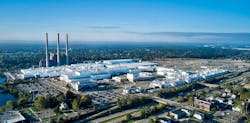So That Happened: Get Those New Workers Trained!
Editor’s note: Welcome to So That Happened, our editors’ takes on things going on in the manufacturing world that deserve some extra attention. This will appear regularly in the Member’s Only section of the site.
Department of Labor Invests Over $244 Million in Registered Apprenticeships
Part of President Joe Biden’s Investing in America agenda, the DOL is awarding more than $244 million to modernize the Registered Apprenticeship system through two grant programs. The learn-and-earn apprenticeship model supports workforce development for underserved populations and communities.
Under the Apprenticeship Building America initiative, $195 million will be invested through the second round of grant funding to expand Registered Apprenticeships in advanced manufacturing, supply chain, IT and cybersecurity, clean energy and other in-demand fields. These grants involve awards in the following categories:
- “Ensuring Equitable Registered Apprenticeship Pathways and Partnerships Through Pre-Apprenticeship.”
- “Creation of Education System-aligned Pre-apprenticeship and Registered Apprenticeship Programs.”
- “Registered Apprenticeship Hubs.”
Additionally, the second round of the competitive portion of the State Apprenticeship Expansion Formula Grants will allow the administration to award $49 million to help recipients do the following:
- “Help states and territories advance Registered Apprenticeship as a talent development strategy and create post-secondary education career pathways that strengthen the nation’s workforce.”
- “Support statewide Registered Apprenticeship strategies to engage industry partners and meet skill demands across today’s growing industry sectors.”
- “Enable states and territories to build capacity to increase Registered Apprenticeship opportunities significantly for all American workers, including women, people of color, individuals with disabilities and other underserved communities.”
“This award, totaling more than $244 million, will help to expand, strengthen and diversify programs that aren’t just one-offs – they create a pipeline of workers with in-demand skills, connecting them with good jobs that create real security for workers and their families,” says Acting Secretary of Labor Julie Su.
—Anna Smith
Cleveland-Cliffs Boosts Canadian Presence with $2.5 Billion Stelco Deal
Cleveland-Cliffs may have been rejected in its efforts to buy U.S. Steel (which looks headed to join Nippon Steel if the $14.9 billion deal closes), but that doesn’t mean the Cleveland-based steel producer is standing still.
Cleveland-Cliffs Inc. on July 15 announced that it would purchase Canada’s Stelco Holdings Inc. in a $2.5 billion transaction that will nearly triple its Canadian employee base.
The deal encompasses two sites located in Ontario: integrated steel-making facility Lake Erie Works in Nanticoke and downstream finishing and coke-making site Hamilton Works. The company annually ships approximately 2.6 million net tons of flat-rolled steel, primarily hot-rolled steel, according to the announcement.
The deal will add 1,800 United Steelworkers employees to Cleveland-Cliffs workforce. Cliffs’ current footprint in Canada numbers approximately 1,000, located in seven tooling and stamping plants and a ferrous processing and trading company. All are in Ontario.
Cleveland-Cliffs said the transaction will result in about $120 million in annual cost savings, with no impact on union jobs.
“The enterprise value of this transaction is significantly lower than the cost of building an equivalent replacement mill in the United States, and the cost structure is lower than what a new U.S. mill would provide us,” Cliffs CEO Lourenco Goncalves said in announcing the acquisition. “Stelco is a company that respects the union, treats their employees well, and leans into their cost advantages. With that, they are a perfect fit for Cleveland-Cliffs and our culture.”
Cleveland-Cliffs ranked No. 22 among the world’s largest steel producers in 2023, according to World Steel Association data. The acquisition of Stelco could boost its ranking a couple of notches.
The deal is expected to close in the fourth quarter, subject to approval by Stelco shareholders and other customary closing conditions. The boards of both Cleveland-Cliffs and Stelco have already approved the sale.
—Jill Jusko
Automakers, Suppliers Detail Energy Department EV Investments
As we reported last week, the U.S. Department of Energy has pledged $1.7 billion in grants to convert gasoline- or diesel-powered vehicle manufacturing in electric vehicles. So, how are companies spending that money?
Stellantis: $585 billion
More than one-third of the total Energy Department spending will go to two projects. Of that, $335 billion will go to converting the Belvidere, Illinois, assembly plant to produce EVs. A storied plant that dates back to 1964 and the home of the Dodge Neon compact, Belvidere has been idle since early 2023 when production of the Jeep Cherokee SUV ended. Stellantis agreed to reopen the plant as an EV battery facility and possible assembly plant during negotiations last year with the United Auto Workers. The rest of the Stellantis grant will go to convert the company’s Kokomo, Indiana, transmission plant to producing electric drive modules.
General Motors: $500 billion
GM announced plans in 2022 to convert much of its Lansing Grand River plant to EVs, and the federal grant accelerates that program. The plant has produced Cadillac car models for the past several years and will continue making the CT4 and CT5 while the EV conversion advances. Camilo Ballesty, GM vice president of North America Manufacturing and Labor Relations, said, “GM’s investment and this Department of Energy grant underscore our commitment to U.S. leadership in manufacturing and innovation, making sure we’re competitive at home and abroad.”
Volvo Technology of America (commercial trucks): $208 billion
The producer of Mack and Volvo-branded heavy-duty trucks plans to add EV production to three assembly plants: Macungie, Pennsylvania; Dublin, Virginia, and Hagerstown, Maryland. The company says the upgrades will allow Volvo to go from having two battery-powered truck offerings to a full lineup of battery- and fuel-cell-powered trucks.
ZF North America Inc.: $158 billion
The largest amount awarded to a Tier 1 automotive supplier, ZF will spend the funds at its Marysville, Michigan, axle drives plant. ZF says it will convert part of that plant’s production from gasoline-centric commercial vehicle axles and components to designs for electric heavy-duty trucks.
Harley-Davidson: $89 billion
The motorcycle maker will expand its York, Pennsylvania, plant to produce Harley-branded electric motorcycles and models from LiveWire, an EV motorcycle company it spun off to investors in 2022 (though it still maintains a large stake). Harley-Davidson says it will retrain 1,300 union workers in Pennsylvania and hire 125 new people as it retools and reinvests in the plant.
Blue Bird: $80 billion
The school bus maker has been a big beneficiary of federal EV spending in recent years. Funded by the same infrastructure spending bill passed in 2021, the Environmental Protection Agency’s Clear School Bus Program provides $5 billion for school districts to convert to electric or other cleaner-than-diesel options for getting kids to school. Blue Bird will use the new funds to convert an idled motorhome plant (Blue Bird ended its Wanderlodge brand in 2019) into a facility for its Type-D EV school buses, creating 400 new jobs. Blue Bird CEO Phil Horlock said the grant will “enable Blue Bird to expand its workforce and invest in a community that is integral to Blue Bird’s history and continued success. We are looking forward to fully participating in the next phase of the negotiation process with the DOE.”
Cummins: $75 billion
The company once associated almost exclusively with diesel commercial vehicle engines has been investing heavily in electrified systems for trucks for several years. The grant will allow it to convert about 25% of its Columbus (Indiana) Engine Plant to make components for its Accelera EV components brand. Following the project, roughly half of the 1.4 million square feet plant will make Accelera components. Accelera by Cummins President Amy Davis said the investment “represents a crucial step in advancing electrification and domestic battery supply chains. Partnership with government, customers, and the industry as a whole is required to accelerate the shift to zero. We are proud of this milestone and to be adding clean tech jobs to develop the workforce and communities of the future.”
Mobis North America: $33 billion
A subsidiary of Korean automotive giant Hyundai, Mobis is one of several major suppliers that has facilities on Stellantis’ Jeep assembly plant campus in Toledo, Ohio. Mobis will convert the internal-combustion-engine chassis line at that plant to ICE or plug-in hybrid chassis (Jeep’s Wrangler 4e plug-in hybrid quietly became the best-selling PHEV in the U.S. in 2022). The company says the investments will support new PHEV trucks, and the company plans to invest some finds to build a battery assembly facility at a former mall about five miles north of the Jeep plant.
—Robert Schoenberger
Can’t Escape AI, Don’t Want to Escape XR
As in any discussion nowadays about new technologies and the role we can expect them to play in our lives in the future, Forrester’s new “Top 10 Emerging Technologies in 2024” report is splattered with references to AI, with generative AI specifically taking a starring role.
According to Forrester, in the short term we will continue to see GenAI used for visual content generation (already happening, see: deepfakes), language (also already happening, see: large language models, bots for customer service, and automated report writing) and TuringBots—AI software used to generate software code (machines making machines: always a good idea).
In the medium term, defined in the report as between two and five years, manufacturing will reap the benefits of autonomous mobility (like AMRs used for intra-plant materials transport) and edge intelligence (like smart vision systems in plants taking real-time quality measurements).
The report’s most interesting prediction, to me, is the long-term rise of extended reality (XR). As an early adopter and frequent user of commercial VR I’m biased on the topic but I think of all the technologies in the report XR has the most potential to fundamentally change manufacturing in a meaningful, long-term fashion.
Training, onboarding and knowledge capture define the best, current use cases for XR and manufacturing is well ahead on the adoption curve. Autodesk offers factory design software that allows people to strap on a VR headset and “walk” through accurate 3D representations of what new plants will look like. When I attended Siemens’ Realize Live event in Last Vegas this year, Siemens demonstrated a new VR rig for engineering applications designed in partnership with Sony.
Hand tracking has come a long way. I imagine people in digital command centers at plants wearing XR rigs and using hand motions to flip through dozens of projected displays, monitoring digital twins and accessing the information much more quickly (and on much larger “screens”) that is possible with even the best computer setups.
I imagine operators equipped with smart glasses as standard floor equipment, getting the same sort of productivity info currently displayed on large boards or HMIs on the factory floor but instead displayed in virtual screens hovering at the edge of their peripheral vision.
Manufacturing is on the vanguard of XR adoption, so I don’t think these use cases are fantasy. I think they’re coming, maybe sooner than the Forrester report would have us believe.
—Dennis Scimeca
CNC in NYC
In other training news, the Brooklyn Navy Yard Development Corp. has started its sixth cohort of its CNC operator training program, which is open to anyone regardless of skill level or manufacturing experience.
The program uses an on-site CNC facility provided by Nanotronics, a tech company and Brooklyn Navy Yard tenant, and leverages other manufacturers in the area to train applicants in operating CNC mills and lathes, hand tools, and other manufacturing software. The program also supports four metalworking certificates from the National Institute for Metalworking Skills and two certificates from Haas:
- Measurements, Materials, and Safety (NIMS)
- Job Planning, Benchwork, and Layout (NIMS)
- Lathe Programming, Setup, and Operations (NIMS)
- Mill Programming, Setup, and Operations (NIMS)
- CNC Lathe Operations (Haas)
- CNC Mill Operations (Haas)
—Ryan Secard
About the Author
Anna Smith
News Editor
News Editor
LinkedIn: https://www.linkedin.com/in/anna-m-smith/
Bio: Anna Smith joined IndustryWeek in 2021. She handles IW’s daily newsletters and breaking news of interest to the manufacturing industry. Anna was previously an editorial assistant at New Equipment Digest, Material Handling & Logistics and other publications.
Jill Jusko
Bio: Jill Jusko is executive editor for IndustryWeek. She has been writing about manufacturing operations leadership for more than 20 years. Her coverage spotlights companies that are in pursuit of world-class results in quality, productivity, cost and other benchmarks by implementing the latest continuous improvement and lean/Six-Sigma strategies. Jill also coordinates IndustryWeek’s Best Plants Awards Program, which annually salutes the leading manufacturing facilities in North America.
Have a story idea? Send it to [email protected].
Robert Schoenberger
Editor-in-Chief
LinkedIn: linkedin.com/in/robert-schoenberger-4326b810
Bio: Robert Schoenberger has been writing about manufacturing technology in one form or another since the late 1990s. He began his career in newspapers in South Texas and has worked for The Clarion-Ledger in Jackson, Mississippi; The Courier-Journal in Louisville, Kentucky; and The Plain Dealer in Cleveland where he spent more than six years as the automotive reporter. In 2014, he launched Today's Motor Vehicles (now EV Manufacturing & Design), a magazine focusing on design and manufacturing topics within the automotive and commercial truck worlds. He joined IndustryWeek in late 2021.
Dennis Scimeca
Dennis Scimeca is a veteran technology journalist with particular experience in vision system technology, machine learning/artificial intelligence, and augmented/mixed/virtual reality (XR), with bylines in consumer, developer, and B2B outlets.
At IndustryWeek, he covers the competitive advantages gained by manufacturers that deploy proven technologies. If you would like to share your story with IndustryWeek, please contact Dennis at [email protected].
Ryan Secard
Associate Editor
Ryan Secard joined Endeavor B2B in 2020 as a news editor for IndustryWeek. He currently contributes to IW, American Machinist, Foundry Management & Technology, and Plant Services on breaking manufacturing news, new products, plant openings and closures, and labor issues in manufacturing.




